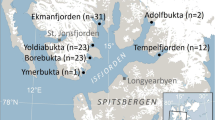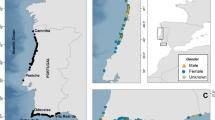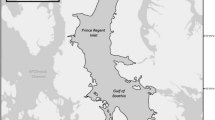Abstract
Competition between Kuril harbor seals (Phoca vitulina stejnegeri) and salmon set-net fishing industries has become a serious problem with the recent increase in the number of seals in Erimo, Hokkaido, Japan. We aimed to understand the detailed dietary structure of Kuril harbor seals focusing on intraspecific differences and verify whether “problem seals” who habitually use salmon set-nets could be characterized by intrinsic factors such as sex and maturity. We estimated the diet of Kuril harbor seals in two fishing seasons using DNA barcoding diet analysis on colon contents and verified intraspecific differences in their diet. In spring, their diets showed different tendencies between maturity stage; each adult seal fed on different prey items, suggesting that they avoid the intraspecies competition over food during the breeding season. Additionally, it was implied that some adult females habitually stole from salmon set-nets. Our dietary analysis showed dietary changes of Kuril harbor seals with different tendencies depending on maturity or sex, suggesting that problem individuals who habitually use set-nets can be characterized by intrinsic factors. This detailed dietary information can offer an accurate assessment of seal predation effects on fishing targets and the selective management of Kuril harbor seals, especially in mitigating seal–commercial fishery conflicts.





Similar content being viewed by others
Data availability
The datasets generated during and/or analyzed during the current study are available from the corresponding author on reasonable request.
Code availability
Not applicable.
Change history
19 August 2021
A Correction to this paper has been published: https://doi.org/10.1007/s13364-021-00592-5
References
Andersen SM, Lydersen C, Grahl-Nielsen O, Kovacs KM (2004) Autumn diet of harbour seals (Phoca vitulina) at Prins Karls Forland, Svalbard, assessed via scat and fatty-acid analyses. Can J Zool 82:1230–1245. https://doi.org/10.1139/z04-093
Anderson MJ (2001) A new method for non-parametric multivariate analysis of variance. Austral Ecol 26(1):32–46. https://doi.org/10.1111/j.1442-9993.2001.01070.pp.x
Beck CA, Bowen WD, McMillan JI, Iverson SJ (2003) Sex differences in the diving behaviour of a size-dimorphic capital breeder: the grey seal. Anim Behav 66(4):777–789. https://doi.org/10.1006/anbe.2003.2284
Beck CA, Iverson SJ, Bowen WD, Blanchard W (2007) Sex differences in grey seal diet reflect seasonal variation in foraging behaviour and reproductive expenditure: evidence from quantitative fatty acid signature analysis. J Anim Ecol 76:490–502. https://doi.org/10.1111/j.1365-2656.2007.01215.x
Boness DJ, Bowen WD, Buhleier BM, Marshall GJ (2006) Mating tactics and mating system of an aquatic-mating pinniped: the harbor seal, Phoca vitulina. Behav Ecol Sociobiol 61:119–130. https://doi.org/10.1007/s00265-006-0242-9
Bowen WD (2000) Reconstruction of pinniped diets: accounting for complete digestion of otoliths and cephalopod beaks. Can J Fish Aquat Sci 57:898–905. https://doi.org/10.1139/f00-032
Boyle PR, Pierce GJ, Diack JSW (1990) Sources of evidence for salmon in the diet of seals. Fish Res 10:137–150. https://doi.org/10.1016/0165-7836(90)90019-R
Breed G, Bowen WD, McMillan JI, Leonard M (2006) Sexual segregation of seasonal foraging habitats in a non-migratory marine mammal. Proc R Soc B 273:2319–2326. https://doi.org/10.1098/rspb.2006.3581
Brown EG, Pierce GJ (1998) Monthly variation in the diet of harbour seals in inshore waters along the southeast Shetland (UK) coastline. Mar Ecol Prog Ser 167: 275–289. http://www.jstor.org/stable/24827797. Accessed November 26, 2020.
Bundy A, George RL, Peter AS (2000) A mass balance model of the Newfoundland-Labrador Shelf. Can Tech Rep Fish Aquat Sci 2310:xiv + 157 p.
Deagle BE, Kirkwood R, Jarman SN (2009) Analysis of Australian fur seal diet by pyrosequencing prey DNA in faeces. Mol Ecol 18(9):2022–2038. https://doi.org/10.1111/j.1365-294X.2009.04158.x
Deagle BE, Thomas AC, Shaffer AK, Trites AW, Jarman SN (2013) Quantifying sequence proportions in a DNA-based diet study using Ion Torrent amplicon sequencing: which counts count? Mol Ecol Resour 13:620–633. https://doi.org/10.1111/1755-0998.12103
Dietz R, Teilmann J, Andersen SM, Riget F, Olsen MT (2013) Movements and site fidelity of harbour seals (Phoca vitulina) in Kattegat, Denmark, with implications for the epidemiology of the phocine distemper virus. ICES J Mar Sci 70:186–195. https://doi.org/10.1093/icesjms/fss144
Doi H, Okamura H (2011) Similarity indices, ordination, and community analysis tests using the software R. Japanese J Ecol 61:3–20. https://doi.org/10.18960/seitai.61.1_3
Edgar RC (2010) Search and clustering orders of magnitude faster than BLAST. Bioinformatics 26(19):2460–2461. https://doi.org/10.1093/bioinformatics/btq461
Folmer O, Black M, Hoeh W, Lutz R, Vrijenhoek R (1994) DNA primers for amplification of mitochondrial cytochrome c oxidase subunit I from diverse metazoan invertebrates. Mol Mar Biol Biotechnol 3:294–299. https://doi.org/10.1371/journal.pone.0013102
Hall AJ, Watkins J, Hammond PS (1998) Seasonal variation in the diet of harbour seals in the south-western North Sea. Mar Ecol Prog Ser 1170:269–281. https://doi.org/10.3354/meps170269
Hebert PD, Cywinska A, Ball SL, DeWaard JR (2003) Biological identifications through DNA barcodes. Proc R Soc Lond B 270(1512):313–321. https://doi.org/10.1098/rspb.2002.2218
Hebert PD, Gregory TR (2005) The promise of DNA barcoding for taxonomy. Syst Biol 54(5):852–859. https://doi.org/10.1080/10635150500354886
Hui TCY, Morita Y, Kobayashi Y, Mitani Y, Miyashita K (2017) Dietary analysis of harbour seals (Phoca vitulina) from faecal samples and overlap with fisheries in Erimo. Japan Mar Ecol 38(3):e12431. https://doi.org/10.1111/maec.12431
Jaccard P (1908) Nouvelles recherches sur la distribution florale. Bull Soc Vaud Sci Nat 44:23–270. https://doi.org/10.5169/seals-268384
Jobling M, Breiby A (1986) The use and abuse of fish otoliths in studies of feeding habits of marine piscivores. Sarsia 71:265–274. https://doi.org/10.1080/00364827.1986.10419696
Joshi NA, Fass J (2011) Sickle: a sliding-window, adaptive, quality-based trimming tool for FastQ files (version 1.33) [Software]. http://gensoft.pasteur.fr/docs/sickle/1.33
Kauhala K, Kurkilahti M, Ahola MP, Herrero A, Karlsson O, Kunnasranta M, Tiilikainen R, Vetemaa M (2015) Age, sex and body condition of Baltic grey seals: are problem seals a random sample of the population? Ann Zool Fenn 52(1–2):103–114. https://doi.org/10.5735/086.052.0209
Kobayashi Y, Kariya T, Chishima J, Fujii K, Wada K, Baba S, Itoo T, Nakaoka T, Kawashima M, Saito S (2014) Population trends of the Kuril harbour seal Phoca vitulina stejnegeri from 1974 to 2010 in southeastern Hokkaido, Japan. Endang Species Res 24:61–72. https://doi.org/10.3354/esr00553
Krebs CJ (1999) Ecological methodology. Addison Welsey Educational Publishers. Inc., Califórnia
Lance MM, Chang WY, Jeffries SJ, Pearson SF, Acevedo-Gutiérrez A (2012) Harbor seal diet in northern Puget Sound: implications for the recovery of depressed fish stocks. Mar Ecol Prog Ser 464:257–271. https://doi.org/10.3354/meps09880
Leray M, Yang JY, Meyer CP, Mills SC, Agudelo N, Ranwez V, Boehm JT, Machida RJ (2013) A new versatile primer set targeting a short fragment of the mitochondrial COI region for metabarcoding metazoan diversity: application for characterizing coral rock fish gut contents. Front Zool 10:1–14. https://doi.org/10.1186/1742-9994-10-34
Lewis R, O’Connell TC, Lewis M, Campagna C, Hoelzel AR (2006) Sex-specific foraging strategies and resource partitioning in the southern elephant seal (Mirounga leonina). Proc R Soc B Biol Sci 273:2901–2907. https://doi.org/10.1098/rspb.2006.3642
Magoč T, Salzberg SL (2011) FLASH: fast length adjustment of short reads to improve genome assemblies. Bioinformatics 27(21):2957–2963. https://doi.org/10.1093/bioinformatics/btr507
Mansfield AW, Fisher HD (1960) Age determination in the harbour seal. Phoca Vitulina L Nature 186(4718):92–93. https://doi.org/10.1038/186092a0
Markussen NH (1993) Transit time of digesta in captive harbour seals (Phoca vitulina). Can J Zool 71:1071–1073. https://doi.org/10.1139/z93-144
Masubuchi T, Ohyama N, Aizaki S, Okada K, Ohno K, Ishikawa A, Echigo H, Suzuki K, Suruga H, Kobayashi M (2017) Evaluation of the damage to the salmon set trap fishery for salmon by Kuril harbor seals in Cape Erimo, Hokkaido, Japan — first study using both seals behavior and the number of damage —. Wildl Hum Soc 4:19–27. https://doi.org/10.20798/awhswhs.4.2_19
Ministry of Environment, Japan (2017) Ministry of the Environment Erimo Area Kuril Harbor Seal Management Project Implementation Plan, FY 2017. URL: http://hokkaido.env.go.jp/wildlife/mat/SealManagement2017EnglishTranslation.pdf (Accessed 10 March 2021)
Ministry of Environment, Japan (2018) Ministry of the Environment Erimo Area Kuril Harbor Seal Management Project Implementation Plan, FY 2018. URL: http://hokkaido.env.go.jp/wildlife/mat/h300830eiyaku.pdf (Accessed 10 March 2021)
Newton-Fisher NE (1999) The diet of chimpanzees in the Budongo Forest Reserve, Uganda. Afr J Ecol 37:344–354. https://doi.org/10.1046/j.1365-2028.1999.00186.x
Niizuma A (1986) Social behavior and breeding strategy of Kuril seals. In: Wada K, Ito T, Niizuma A, Hayama S, Suzuki M (eds) Ecology and protection of Kuril seals, 1st edn. Tokai University Press, Tokyo, pp 59–103
Oksanen J, Blanchet FG, Friendly M, Kindt R, Legendre P, McGlinn D, Minchin PR, O’Hara RB, Simpson GL, Solymos P, Stevens MHM, Szoecs E, Wagner H (2017) vegan: community ecology package. R package version 2.4–5. https://CRAN.R-project.org/package=vegan
Peterson SH, Lance MM, Jeffries SJ, Acevedo-Gutiérrez A (2012) Long distance movements and disjunct spatial use of harbor seals (Phoca vitulina) in the inland waters of the Pacific Northwest. PloS One 7(6):e39046. https://doi.org/10.1371/journal.pone.0039046
R Core Team (2017) R: a language and environment for statistical computing. R Foundation for Statistical Computing, Vienna, Austria. https://www.R-project.org/.
Schwarz D, Spitzer SM, Thomas AC, Kohnert CM, Keates TR, Acevedo-Gutiérrez A (2018) Large-scale molecular diet analysis in a generalist marine mammal reveals male preference for prey of conservation concern. Ecol Evolution 8(19):9889–9905. https://doi.org/10.1002/ece3.4474
Shaughnessy PD, Fay FH (2009) A review of the taxonomy and nomenclature of North Pacific Harbour seals. J Zool 182:385–419. https://doi.org/10.1111/j.1469-7998.1977.tb03917.x
Smith RD, Metcafe NB (1997) Why does dominance decline with age in wintering snow buntings? Anim Behav 53:313–322. https://doi.org/10.1006/anbe.1996.0403
Suzuki M, Yamashita T (1986) Sexual maturity and developmental stage of Kuril seals. In: Wada K, Ito T, Niizuma A, Hayama S, Suzuki M (eds) Ecology and protection of Kuril seals, 1st edn. Tokai University Press, Tokyo, pp 179–194
Swan GJ, Redpath SM, Bearhop S, McDonald RA (2017) Ecology of problem individuals and the efficacy of selective wildlife management. Trends Ecol Evol 32(7):518–530. https://doi.org/10.1016/j.tree.2017.03.011
Tollit DJ, Schulze AD, Trites AW, Olesiuk PF, Crockford SJ, Gelatt TS, Ream RR, Miller KM (2009) Development and application of DNA techniques for validating and improving pinniped diet estimates. Ecol Appl 19(4):889–905. https://doi.org/10.1890/07-1701.1
Thompson PM, Mackay A, Tollit DJ, Enderby S, Hammond PS (1998) The influence of body size and sex on the characteristics of harbour seal foraging trips. Can J Zool 76(6):1044–1053. https://doi.org/10.1139/z98-035
Voelker MR, Schwarz D, Thomas A, Nelson BW, Acevedo-Gutiérrez A (2020) Large-scale molecular barcoding of prey DNA reveals predictors of intrapopulation feeding diversity in a marine predator. Ecol Evol 10(18):9867–9885. https://doi.org/10.1002/ece3.6638
Wilson K, Lance M, Jeffries S, Acevedo-Gutiérrez A (2014) Fine-scale variability in harbor seal foraging behavior. PloS One 9(4):e92838. https://doi.org/10.1371/journal.pone.0092838
Yodzis P (1998) Local trophodynamics and the interaction of marine mammals and fisheries in the Benguela ecosystem. J Anim Ecol 67:635–658. https://doi.org/10.1046/j.1365-2656.1998.00224.x
Acknowledgements
We are deeply grateful to the Erimo Seal Club, Erimo Fisherman’s Cooperative, Erimo Town Office, the Ministry of the Environment, Japan, and the members of Laboratory of Aquatic Wild Life Management, Tokyo University of Agriculture, for their support during our fieldwork and their efforts to collect samples. We are also grateful to the members of Kita Laboratory, Tokai University, Mr. K. Nakano and the Bioengineering Lab. Co., Ltd., for assisting in DNA analysis. The authors would like to thank MARUZEN-YUSHODO Co., Ltd. (https://kw.maruzen.co.jp/kousei-honyaku/) for the English language editing. We are also grateful for two anonymous reviewers; their comments greatly contributed to improving this study.
Funding
This study is partly supported by the Environment Research and Technology Development Fund of the Ministry of the Environment, Japan, and Japan Society for the Promotion of Science KAKENHI Grant Number 15H05709 and 16KT0140.
Author information
Authors and Affiliations
Contributions
All authors contributed to the study conception and design. Material preparation, data collection, and analysis were performed by MJ, YFK, MK, and YM. The first draft of the manuscript was written by MJ and all authors commented on previous versions of the manuscript. All authors read and approved the final manuscript.
Corresponding author
Ethics declarations
Ethics approval
All harbor seal samples were collected as part of a project conducted by the Ministry of the Environment, Japan, under the Erimo Area Kuril Harbor Seal Specified Rare Wildlife Management Plan.
Consent for participate
All authors agreed to participate in this study and co-authorship.
Consent for publication
All authors agreed with the content and that all gave explicit consent to submit.
Conflict of interest
The authors declare no competing interests.
Additional information
Communicated by Cino Pertoldi.
Publisher's Note
Springer Nature remains neutral with regard to jurisdictional claims in published maps and institutional affiliations.
The original online version of this article was revised: The results in Figure 5 has been corrected.
Rights and permissions
About this article
Cite this article
Jimbo, M., Kita, Y.F., Kobayashi, M. et al. Intraspecific differences in the diet of Kuril harbor seals (Phoca vitulina stejnegeri) in Erimo, Hokkaido, using DNA barcoding diet analysis. Mamm Res 66, 553–563 (2021). https://doi.org/10.1007/s13364-021-00586-3
Received:
Accepted:
Published:
Issue Date:
DOI: https://doi.org/10.1007/s13364-021-00586-3




